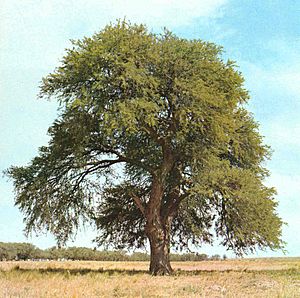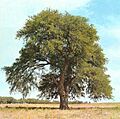Caldén facts for kids
Quick facts for kids Caldén |
|
|---|---|
 |
|
| Conservation status | |
| Scientific classification | |
| Genus: |
Prosopis
|
| Species: |
caldenia
|
The caldén (scientific name: Prosopis caldenia) is a special kind of flowering tree. It belongs to the Fabaceae family, which is also known as the pea or bean family. This tree is found only in the subtropical parts of Argentina.
The caldén tree is very tough! It grows well in sandy, dry soils and can survive long periods without much water. This is because it has an incredibly deep root system that helps it find water far underground.
Its leaves are small and grow in a pattern called "pinnately compound," which means they look like feathers. The leaves fall off every year (deciduous), and they grow in pairs along twisted branches. These branches also have sharp, cone-shaped thorns.
Contents
What is the Caldén Tree?
The caldén is a medium-sized tree that can grow quite tall. It's known for its strong wood and its ability to live in harsh, dry places. This tree is an important part of the natural environment in Argentina.
Where Does the Caldén Grow?
The caldén tree is endemic to Argentina. This means it is found naturally only in that country and nowhere else in the world. It thrives in the central and eastern parts of Argentina, especially in areas with sandy plains and dry climates.
How Does the Caldén Survive Dryness?
One of the most amazing things about the caldén is how it handles drought. Its roots can grow very deep into the ground, sometimes dozens of meters down. This allows the tree to reach underground water sources that other plants can't. This deep root system helps the caldén stay alive even when there hasn't been rain for a long time.
Features of the Caldén Tree
The caldén has several unique features that help it survive and thrive in its environment.
Leaves and Branches
The leaves of the caldén are small and arranged in a way that looks like a feather, which is called "pinnately compound." They are also "deciduous," meaning they fall off the tree during certain seasons, usually in winter. The branches are often twisted and have sharp, cone-shaped thorns that grow in pairs. These thorns might help protect the tree from animals.
Flowers and Seeds
Like all flowering plants, the caldén produces flowers. These flowers eventually turn into pods that contain seeds. The seeds are how the tree reproduces and spreads to new areas. The pods are often eaten by animals, which helps to spread the seeds even further.
Importance of the Caldén
The caldén tree is important for many reasons, both for nature and for people.
Wildlife Habitat
The caldén forests provide a home for many different animals, including birds, insects, and mammals. The trees offer shelter, food (like their pods), and places for animals to raise their young.
Wood and Resources
The wood of the caldén tree is very strong and durable. It has been used by people for various purposes, such as building materials, fence posts, and firewood.
Protecting the Soil
Because the caldén has such deep roots, it helps to hold the soil in place. This is very important in sandy, dry areas where wind and water can easily cause soil erosion. By keeping the soil stable, the caldén helps to prevent deserts from spreading.
Conservation Status
The caldén tree is currently listed as "Data Deficient" by the IUCN (International Union for Conservation of Nature). This means that there isn't enough information available right now to know exactly how healthy its population is or if it's at risk of disappearing. Scientists need to do more research to understand its status better.
See also
- In Spanish: Caldén para niños
Images for kids



